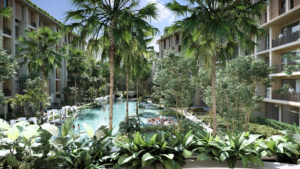
In most areas, property rentals increased by double digits over the last year, as shown by the September rental report from PropTrack.
The proportion of rental properties advertised on realestate.com.au for less than $400 decreased from 41.8 percent at the outbreak’s onset to 19.3 percent in September 2022.
Similar to PropTrack’s rental series, other data sources have shown a double-digit yearly rise in Australia’s asking rentals.
During the pandemic, the need for additional space, the rising tendency to work from home, and the requirement for home offices constricted the rental market in Australia. This has led to a dramatic decline in the number of persons per residence, which has boosted rental demand despite slow population growth:
The advent of rental platforms like Airbnb, which have allowed property owners to pivot to the short-term market, is also likely to have decreased rental availability.
The second tendency may have been especially evident in Australia’s tourist destinations, several of which grew in tandem with domestic tourism during the last two years.
Record immigration devastates the rental market.
The phenomenon of working from home seems to be a structural change that is hard to reverse. Therefore, we should not anticipate the population density to return to pre-Covid levels very soon.
Meanwhile, immigration into Australia is gaining momentum, with net foreign migration reaching a record high of 96,200 arrivals in the March quarter.
Monthly student visa applications in the first half of 2022 surpassed pre-pandemic levels. And Coolabah Capital’s study of higher frequency visa data reveals that foreign student arrivals soared to 500,000 annually during the September quarter, while work visas also increased.
The significant increase in student visas follows the elimination of the restriction on the number of hours students may work while studying by the previous Morrison government late last year, as well as the granting of two-year post-study work privileges to graduates of the Vocational Education and Training (VET) sector.
The Albanese Government then used last month’s Jobs & Skills Summit to declare that it will facilitate next year’s record-breaking immigration through:
• Increasing the annual inflow of permanent non-humanitarian migrants by 30,000 to a record high of 195,000
• Increasing transient migration by:
— Expanding work privileges for overseas students by removing the restriction on the number of hours they may work throughout their studies for an extra year and extending the duration of post-study work visas by two years.
— Committing to eliminating the backlog of roughly one million pending visas.
The Department of Home Affairs has already decided on over two million temporary and permanent visa applications in the last four months. Despite this, there is still a visa “backlog” of 872,000 applications, which the government has pledged to remove as swiftly as possible.
The soon-to-be record number of students and migrants coming to Australia implies further difficulties for the nation’s rental market, particularly in the big cities where most new arrivals are concentrated.
Where will they reside when there is already a severe housing shortage for the current population?
Hundreds of thousands of more individuals seeking rental housing would undoubtedly reduce rental vacancy rates to record lows, drive up prices, and cause more people to become homeless.
As a result of multiple builder bankruptcies and escalating input prices, house building is also expected to decline.
Increased rents will feed inflation, leading to a rise in interest rates.
Rents now account for around 6% of the Consumer Price Index (CPI) – the Reserve Bank of Australia’s (RBA) primary inflationary indicator used to determine interest rates.
Curiously, the Australian Bureau of Statistics (ABS) rental series, as measured by the CPI, increased by just 1.6% in the year leading up to June 2022, which was almost one-quarter the pace of headline inflation (6.1 percent).
Consequently, the ABS’s rentals metric is severely behind and does not accurately represent the market, as assessed by PropTrack and other housing data sources.
Once the ABS changes its rental series to reflect the current market, ABS rentals will increase, contributing considerably to Australia’s inflation rate.








